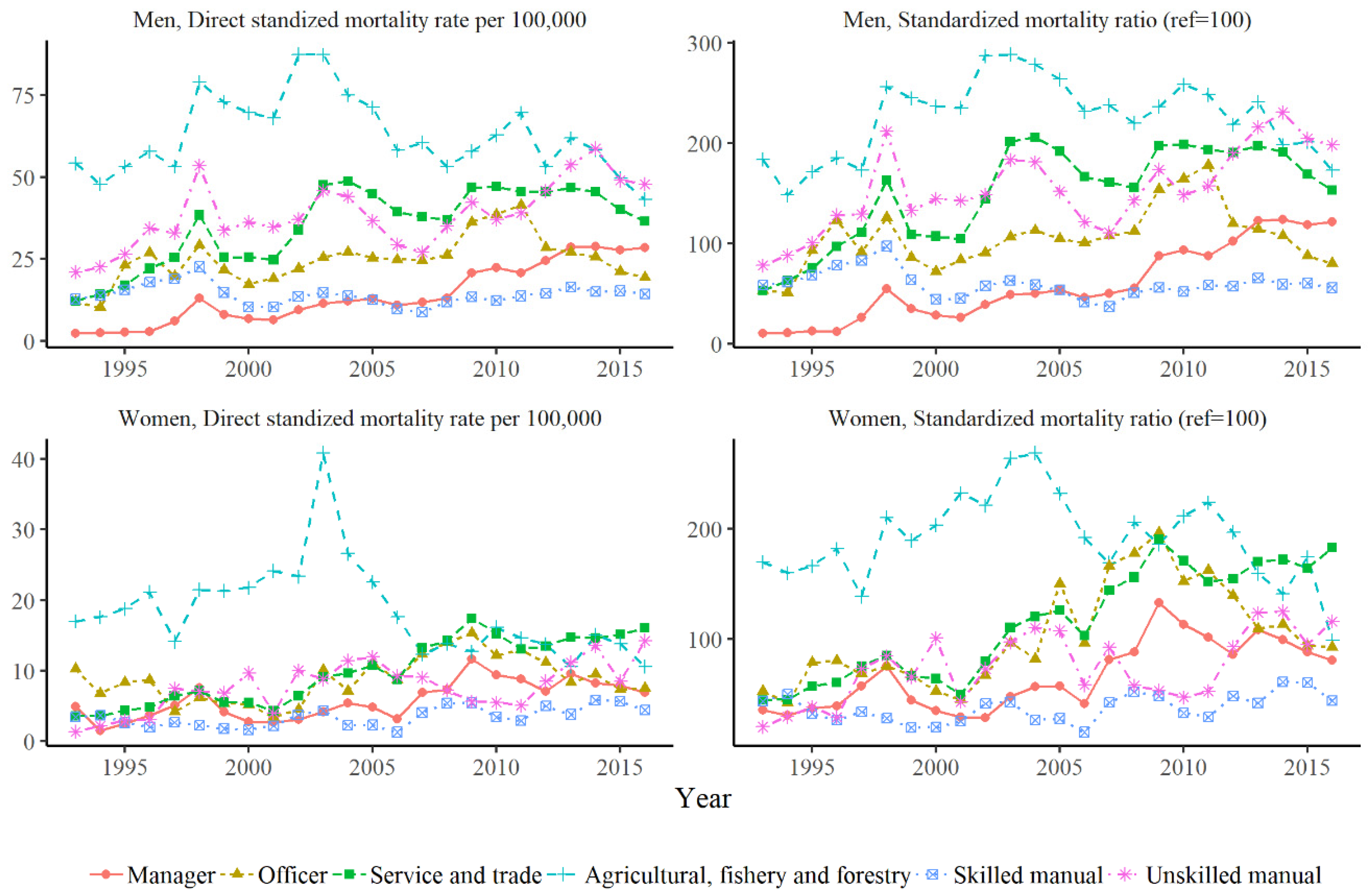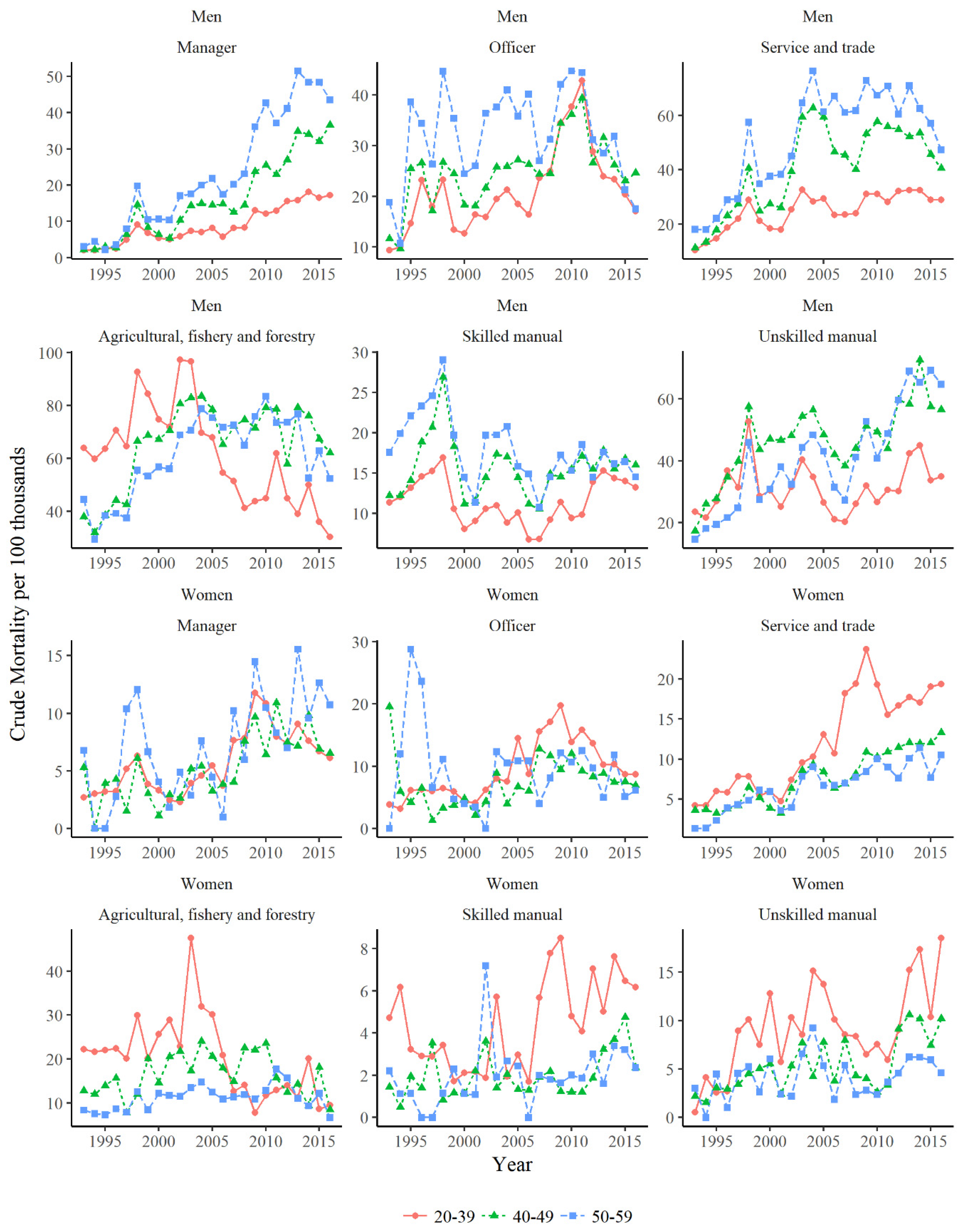Suicide Trends over Time by Occupation in Korea and Their Relationship to Economic Downturns
Abstract
1. Introduction
2. Methods
2.1. Approval of the Research Protocol
2.2. Statistical Analysis
3. Results
4. Discussion
5. Conclusions
Supplementary Materials
Author Contributions
Funding
Conflicts of Interest
References
- Organisation for Economic Co-operation and Development (OECD). Health at a Glance 2017: OECD Indicators; OECD Publishing: Paris, France, 2017. [Google Scholar]
- Li, Z.; Li, Z.; Page, A.; Martin, G.; Taylor, R. Attributable risk of psychiatric and socio-economic factors for suicide from individual-level, population-based studies: A systematic review. Soc. Sci. Med. 2011, 72, 608–616. [Google Scholar] [CrossRef] [PubMed]
- Milner, A.; Page, A.; LaMontagne, A.D. Cause and effect in studies on unemployment, mental health and suicide: A meta-analytic and conceptual review. Psychol. Med. 2014, 44, 909–917. [Google Scholar] [CrossRef] [PubMed]
- Milner, A.; Spittal, M.J.; Pirkis, J.; LaMontagne, A.D. Suicide by occupation: Systematic review and meta-analysis. Br. J. Psychiatry 2013, 203, 409–416. [Google Scholar] [CrossRef] [PubMed]
- Durkheim, E. Suicide: A Study in Sociology [1897] (Translated by J.A. Spaulding and G. Simpson); The Free Press: Glencoe, IL, USA, 1951. [Google Scholar]
- Hawton, K.; Harriss, L.; Hodder, K.; Simkin, S.; Gunnell, D. The influence of the economic and social environment on deliberate self-harm and suicide: An ecological and person-based study. Psychol. Med. 2001, 31, 827–836. [Google Scholar] [CrossRef] [PubMed]
- Yoon, J.H.; Junger, W.; Kim, B.W.; Kim, Y.J.; Koh, S.B. Investigating the Time Lag Effect between Economic Recession and Suicide Rates in Agriculture, Fisheries, and Forestry Workers in Korea. Saf. Health Work 2012, 3, 294–297. [Google Scholar] [CrossRef] [PubMed]
- Page, A.; Taylor, R.; Hall, W.; Carter, G. Mental disorders and socioeconomic status: Impact on population risk of attempted suicide in australia. Suicide Life Threat. Behav. 2009, 39, 471–481. [Google Scholar] [CrossRef] [PubMed]
- Frasquilho, D.; Matos, M.G.; Salonna, F.; Guerreiro, D.; Storti, C.C.; Gaspar, T.; Caldas-de-Almeida, J.M. Mental health outcomes in times of economic recession: A systematic literature review. BMC Public Health 2016, 16, 115. [Google Scholar] [CrossRef] [PubMed]
- Suzuki, E.; Kashima, S.; Kawachi, I.; Subramanian, S.V. Prefecture-level economic conditions and risk of suicide in Japan: A repeated cross-sectional analysis 1975–2010. Eur. J. Public Health 2014, 24, 949–954. [Google Scholar] [CrossRef] [PubMed]
- Oyesanya, M.; Lopez-Morinigo, J.; Dutta, R. Systematic review of suicide in economic recession. World J. Psychiatry 2015, 5, 243–254. [Google Scholar] [CrossRef]
- Chang, S.S.; Gunnell, D.; Sterne, J.A.; Lu, T.H.; Cheng, A.T. Was the economic crisis 1997–1998 responsible for rising suicide rates in East/Southeast Asia? A time–trend analysis for Japan, Hong Kong, South Korea, Taiwan, Singapore and Thailand. Soc. Sci. Med. 2009, 68, 1322–1331. [Google Scholar] [CrossRef]
- Madianos, M.G.; Alexiou, T.; Patelakis, A.; Economou, M. Suicide, unemployment and other socioeconomic factors: Evidence from the economic crisis in Greece. Eur. J. Psychiatry 2014, 28, 39–49. [Google Scholar] [CrossRef]
- Roberts, S.E.; Jaremin, B.; Lloyd, K. High-risk occupations for suicide. Psychol. Med. 2013, 43, 1231–1240. [Google Scholar] [CrossRef] [PubMed]
- Amagasa, T.; Nakayama, T.; Takahashi, Y. Karojisatsu in Japan: Characteristics of 22 cases of work-related suicide. J. Occup. Health 2005, 47, 157–164. [Google Scholar] [CrossRef] [PubMed]
- Korea Statistics. Korea Statistical Information System (KOSIS) Statistics DB. 2018. Available online: http://kosis.kr/eng (accessed on 25 March 2019).
- R Development Core Team. R: A Language and Environment for Statistical Computing. 2019. Available online: http://www.R-project.org/ (accessed on 25 March 2019).
- Yoon, J.H.; Lee, K.H.; Hahn, K.Y.; Chang, S.J.; Cha, B.S.; Min, S.H.; Lee, K.S.; Chae, H.S.; Eom, A.; Koh, S.B. Suicide Trend of Standardized Mortality Ratio and Age Standardized Proportion Mortality Ratio According to Occupational Groups in Korea: 1993–2007. Korean J. Occup. Environ. Med. 2011, 23, 173–182. [Google Scholar]
- Crotty, J.; Lee, K.K. Is financial liberalization good for developing nations? The case of South Korea in the 1990s. Rev. Radic. Polit. Econ. 2002, 34, 327–334. [Google Scholar] [CrossRef]
- Suzuki, E.; Kashima, S.; Kawachi, I.; Subramanian, S.V. Social and geographical inequalities in suicide in Japan from 1975 through 2005: A census-based longitudinal analysis. PLoS ONE 2013, 8, e63443. [Google Scholar] [CrossRef] [PubMed]
- Han, B.; Crosby, A.E.; Ortega, L.A.; Parks, S.E.; Compton, W.M.; Gfroerer, J. Suicidal ideation, suicide attempt, and occupations among employed adults aged 18–64 years in the United States. Compr. Psychiatry 2016, 66, 176–186. [Google Scholar] [CrossRef]
- Milner, A.J.; Niven, H.; LaMontagne, A.D. Occupational class differences in suicide: Evidence of changes over time and during the global financial crisis in Australia. BMC Psychiatry 2015, 15, 223. [Google Scholar] [CrossRef]
- Barth, A.; Sögner, L.; Gnambs, T.; Kundi, M.; Reiner, A.; Winker, R. Socioeconomic factors and suicide: An analysis of 18 industrialized countries for the years 1983 through 2007. J. Occup. Environ. Med. 2011, 53, 313–317. [Google Scholar] [CrossRef]
- Stuckler, D.; Basu, S.; Suhrcke, M.; Coutts, A.; McKee, M. The public health effect of economic crises and alternative policy responses in Europe: An empirical analysis. Lancet 2009, 374, 315–323. [Google Scholar] [CrossRef]
- Hegerl, U.; Rummel-Kluge, C.; Värnik, A.; Arensman, E.; Koburger, N. Alliances against depression–A community based approach to target depression and to prevent suicidal behaviour. Neurosci. Biobehav. Rev. 2013, 37, 2404–2409. [Google Scholar] [CrossRef] [PubMed]
- de Beurs, D.P.; Hooiveld, M.; Kerkhof, A.J.; Korevaar, J.C.; Donker, G.A. Trends in suicidal behaviour in Dutch general practice 1983–2013: A retrospective observational study. BMJ Open 2016, 6, e010868. [Google Scholar] [CrossRef] [PubMed]
- Landsbergis, P.A. Assessing the contribution of working conditions to socioeconomic disparities in health: A commentary. Am. J. Ind. Med. 2010, 53, 95–103. [Google Scholar] [CrossRef] [PubMed]
- Suh, T.W. Current situation and trends of suicidal deaths, ideas and attempts in Korea. Health Soc. Welf. Rev. 2001, 21, 157–176. [Google Scholar]


| Occupations | Observed Death | Direct Standardized Mortality (Per 100,000) | Standardized Mortality Ratio |
|---|---|---|---|
| Men | |||
| Manager | 8849 | 13.96 (13.93–13.99) | 59.67 (58.43–60.93) |
| Officer | 9515 | 24.73 (24.69–24.77) | 108.76 (106.59–110.97) |
| Service-Trade | 15,194 | 35.37 (35.32–35.42) | 152.87 (150.45–155.32) |
| Agricultural-Fishery-Forestry | 8949 | 62.75 (62.69–62.81) | 221.55 (216.98–226.19) |
| Skilled Manual | 11,438 | 14.06 (14.03–14.09) | 58.99 (57.91–60.08) |
| Unskilled Manual | 7992 | 38.54 (38.49–38.59) | 160.18 (156.69–163.73) |
| Women | |||
| Manager | 2442 | 5.83 (5.80–5.85) | 74.17 (71.26–77.18) |
| Officer | 2962 | 8.80 (8.77–8.83) | 110.37 (106.43–114.42) |
| Service-Trade | 5082 | 9.91 (9.88–9.94) | 120.38 (117.09–123.74) |
| Agricultural-Fishery-Forestry | 1805 | 18.43 (18.39–18.47) | 191.86 (183.11–200.92) |
| Skilled Manual | 536 | 3.44 (3.42–3.46) | 37.52 (34.41–40.83) |
| Unskilled Manual | 796 | 7.71 (7.68–7.74) | 75.38 (70.23–80.80) |
| Age Group | Manager | Officer | Service-Trade | Agricultural-Fishery-Forestry | Skilled Manual | Unskilled Manual | ||||||
|---|---|---|---|---|---|---|---|---|---|---|---|---|
| Beta | p-Value | Beta | p-Value | Beta | p-Value | Beta | p-Value | Beta | p-Value | Beta | p-Value | |
| Unemployment rate (%) | ||||||||||||
| 20–24 | −0.057 | 0.927 | −2.213 | 0.065 | −0.171 | 0.819 | 0.899 | 0.389 | 1.058 | 0.439 | 1.617 | 0.002 |
| 25–29 | 1.254 | 0.414 | 1.669 | 0.569 | 2.774 | 0.197 | 2.378 | 0.201 | 6.153 | 0.034 | 3.178 | 0.003 |
| 30–34 | 3.528 | 0.163 | 4.841 | 0.248 | 7.010 | 0.063 | 6.305 | 0.018 | 6.091 | 0.142 | 4.356 | 0.011 |
| 35–39 | 6.108 | 0.095 | 6.747 | 0.121 | 10.791 | 0.020 | 9.576 | 0.001 | 12.608 | 0.008 | 7.950 | 0.002 |
| 40–44 | 8.045 | 0.139 | 6.077 | 0.186 | 13.199 | 0.041 | 11.395 | 0.000 | 17.800 | 0.001 | 9.104 | 0.012 |
| 45–49 | 5.045 | 0.412 | 6.734 | 0.150 | 10.635 | 0.134 | 11.111 | 0.001 | 14.329 | 0.009 | 8.042 | 0.076 |
| 50–54 | 3.151 | 0.622 | 3.278 | 0.418 | 9.717 | 0.182 | 9.593 | 0.018 | 6.129 | 0.231 | 7.408 | 0.164 |
| 55–59 | 4.110 | 0.411 | 1.984 | 0.406 | 8.234 | 0.120 | 14.256 | 0.001 | 6.118 | 0.135 | 4.717 | 0.312 |
| GDP growth rate (%) | ||||||||||||
| 20–24 | −0.506 | 0.013 | −0.020 | 0.962 | −0.564 | 0.021 | 0.456 | 0.237 | 0.610 | 0.182 | −0.154 | 0.396 |
| 25–29 | −1.758 | 0.000 | −2.141 | 0.026 | −2.049 | 0.003 | 0.608 | 0.334 | 0.173 | 0.865 | −0.435 | 0.243 |
| 30–34 | −2.581 | 0.002 | −2.954 | 0.033 | −3.183 | 0.011 | 1.219 | 0.191 | 0.607 | 0.669 | −0.824 | 0.153 |
| 35–39 | −2.784 | 0.022 | −2.755 | 0.058 | −3.213 | 0.042 | 1.232 | 0.246 | −0.773 | 0.643 | −1.014 | 0.261 |
| 40–44 | −3.900 | 0.030 | −2.401 | 0.116 | −5.111 | 0.018 | 0.913 | 0.423 | −2.088 | 0.267 | −1.730 | 0.165 |
| 45–49 | −3.662 | 0.074 | −3.360 | 0.046 | −4.681 | 0.048 | 0.549 | 0.651 | −3.733 | 0.072 | −2.084 | 0.174 |
| 50–54 | −3.398 | 0.103 | −1.471 | 0.285 | −4.732 | 0.051 | 0.254 | 0.857 | −1.069 | 0.533 | −2.934 | 0.101 |
| 55–59 | −2.393 | 0.159 | −0.387 | 0.622 | −3.585 | 0.043 | −0.222 | 0.884 | −2.575 | 0.074 | −2.530 | 0.099 |
© 2019 by the authors. Licensee MDPI, Basel, Switzerland. This article is an open access article distributed under the terms and conditions of the Creative Commons Attribution (CC BY) license (http://creativecommons.org/licenses/by/4.0/).
Share and Cite
Yoon, J.-H.; Jung, S.J.; Choi, J.; Kang, M.-Y. Suicide Trends over Time by Occupation in Korea and Their Relationship to Economic Downturns. Int. J. Environ. Res. Public Health 2019, 16, 2007. https://doi.org/10.3390/ijerph16112007
Yoon J-H, Jung SJ, Choi J, Kang M-Y. Suicide Trends over Time by Occupation in Korea and Their Relationship to Economic Downturns. International Journal of Environmental Research and Public Health. 2019; 16(11):2007. https://doi.org/10.3390/ijerph16112007
Chicago/Turabian StyleYoon, Jin-Ha, Sun Jae Jung, Jaesung Choi, and Mo-Yeol Kang. 2019. "Suicide Trends over Time by Occupation in Korea and Their Relationship to Economic Downturns" International Journal of Environmental Research and Public Health 16, no. 11: 2007. https://doi.org/10.3390/ijerph16112007
APA StyleYoon, J.-H., Jung, S. J., Choi, J., & Kang, M.-Y. (2019). Suicide Trends over Time by Occupation in Korea and Their Relationship to Economic Downturns. International Journal of Environmental Research and Public Health, 16(11), 2007. https://doi.org/10.3390/ijerph16112007







